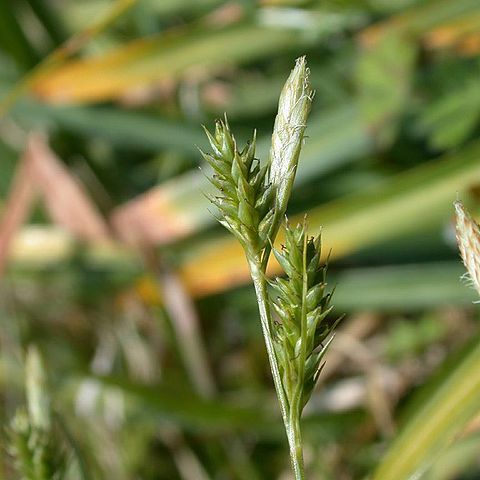Rhizome short or elongate and stoloniferous. Culms tufted, 8-40 cm tall, trigonous, scabrid above. Basal sheaths pale brown, split into fibers. Leaves shorter than culm, blades 2-3(-5) mm wide, flat, stiff, margins scabrid. Lowest involucral bract leafy, longer than inflorescence, shortly sheathed, sheath 1.5-2 mm, remaining bracts bristlelike, nearly sheathless. Spikes 2-5, upper ones contiguous, lower ones spaced; terminal spike male, oblong, 10-15 × 2-3 mm, subsessile, close to next female spike; lateral spikes female, oblong or oblong-ovate, subcylindric, 6-15(-20) × 3-4 mm, densely flowered, sessile or lowest one with peduncle 2-3 mm. Female glumes pale, oblong or obovate-oblong, 2-2.5 (excluding awn) × 1.2-2 mm, membranous, green costa 3-veined and excurrent into an awn 2-3.5 mm, apex truncate or rounded. Utricles pale green, nearly equaling glume, obovate, obtusely trigonous, membranous, densely puberulent above, several veined, base attenuate and shortly stipitate, apex abruptly contracted into a conic beak, orifice emarginate. Nutlet chestnut-colored, tightly enveloped, ovate, ca. 1.8 mm, apex discoid-annulate; style base conically thickened; stigmas 3.
Rhizomatous; tufts often low-growing, close-packed, bright green. Culms hidden among lvs, us. 1–2 cm. long; basal sheaths dull brown. Lvs much > culms, 1.5–2.5–(3) mm. wide, grasslike, recurved, channelled, margins exceedingly finely and closely scabrid almost throughout. Spikes 2–5, approximate, pale green; terminal spike male, us. sessile; remaining spikes female, occ. with a few male fls at the top, 6–9 mm. long, ± pedunculate, clustered round base of male spike; subtending bracts lf-like, very narrow-linear, the uppermost almost filiform, margins finely scabrid. Glumes > utricles, ovate, pale green, almost white, membr., midrib green, stiff, thickened, produced to a stout, finely hispid awn. Utricles c. 2.5 × 1 mm., biconvex or subtrigonous, fusiform, pale yellow-green, faintly many-nerved, pubescent all over; beak slightly narrowed, pale green, c. 0.5 mm. long, orifice ± truncate; stipe c. 0.3 mm. long, often much contracted. Stigmas 3. Nut c. 1.5 mm. long, obtusely trigonous, oblong, obovoid, light brown, surmounted by a minute, persistent, dilated style-base.
Bright green, often low-growing, grass-like tufts 3-30 cm high, with short stems hidden among leaves; rhizome short to long. Spikes 2-5, crowded, hidden, very pale green, < 1 cm long. Utricles pubescent all over. Stigmas 3.

